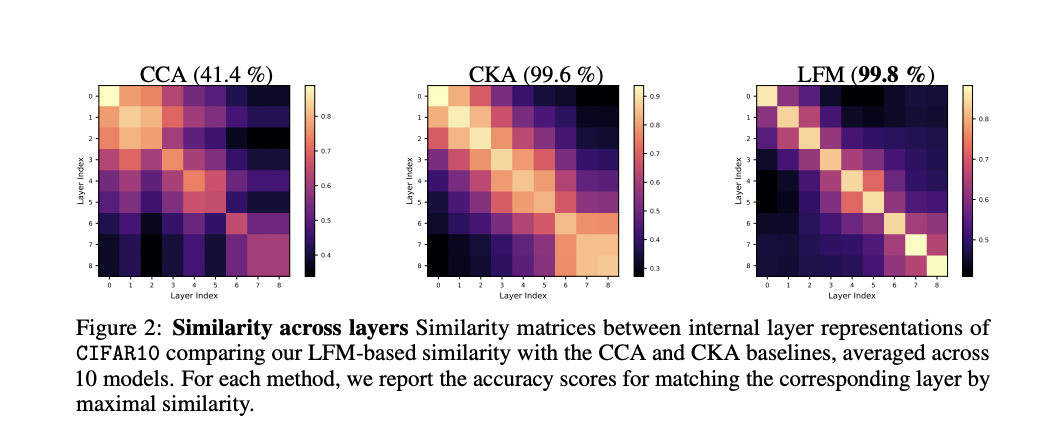Neural networks (NN) remarkably transform high-dimensional data into compact, lower-dimensional latent spaces. While researchers traditionally focus on model outputs such as classification or generation, understanding the internal representation geometry has become a critical area of research. These internal representations offer deep insights into the functionality of neural networks, allowing researchers to reuse learned features for subsequent tasks and compare the structural properties of different models. Exploring these representations provides a deeper understanding of how neural networks process and encode information, revealing underlying patterns that transcend the architectures of individual models.
Comparing representations learned using neural models is crucial in several research domains, from representation analysis to latent space alignment. Researchers have developed multiple methodologies to measure similarity between different spaces, ranging from functional performance comparisons to representational space comparisons. Canonical correlation analysis (CCA) and its adaptations, such as singular vector canonical correlation analysis (SVCCA) and projection-weighted canonical correlation analysis (PWCCA), have emerged as classical statistical methods for this purpose. Centered kernel alignment (CKA) offers another approach to measuring latent spatial similarities, although recent studies have highlighted its sensitivity to local changes, indicating the need for more robust analytical techniques.
Researchers from IST Austria and Sapienza, University of Rome have pioneered a robust approach to understanding neural network representations by moving from sample-level relationships to modeling mappings between functional spaces. The proposed method, Latent Functional Map (LFM)uses principles of spectral geometry to provide a comprehensive framework for representational alignment. By applying functional mapping techniques originally developed for 3D geometry processing and graphics applications, LFM provides a flexible tool for comparing and matching different representation spaces. This innovative approach enables unsupervised and weakly supervised methods to transfer information between different neural network representations, presenting a significant advance in understanding the intrinsic structures of learned latent spaces.
LFM involves three critical steps: constructing a graphical representation of the latent space, encoding preserved quantities through descriptive functions, and optimizing the functional map between different representation spaces. By constructing a symmetric k-nearest neighbor graph, the method captures the underlying manifold geometry, allowing for a nuanced exploration of neural network representations. The technique can handle latent spaces of arbitrary dimensions and provides a flexible tool for comparing and transferring information between different neural network models.

The LFM similarity measure demonstrates remarkable robustness compared to the widely used CKA method. While CKA is sensitive to local transformations that preserve linear separability, the LFM approach maintains stability across various perturbations. The experimental results reveal that the similarity of LFM remains consistently high even when the input spaces undergo significant changes, in contrast to the performance degradation of CKA. Visualization techniques, including t-SNE projections, highlight the method's ability to localize distortions and maintain semantic integrity, particularly in challenging classification tasks involving complex data representations.



The research introduces Latent functional maps as an innovative approach to understanding and analyzing neural network representations. The method provides a comprehensive framework for comparing and aligning latent spaces in different models by applying spectral geometry principles. The approach demonstrates significant potential to address critical challenges in representation learning, offering a robust methodology for finding correspondences and transferring information with minimal anchor points. This innovative technique extends the functional map framework to high-dimensional spaces, presenting a versatile tool for exploring the intrinsic structures and relationships between neural network representations.
Verify he Paper. All credit for this research goes to the researchers of this project. Also, don't forget to follow us on <a target="_blank" href="https://twitter.com/Marktechpost”>twitter and join our Telegram channel and LinkedIn Grabove. Don't forget to join our SubReddit over 60,000 ml.
(You must subscribe): Subscribe to our newsletter to receive updates on ai research and development
Asjad is an internal consultant at Marktechpost. He is pursuing B.tech in Mechanical Engineering from Indian Institute of technology, Kharagpur. Asjad is a machine learning and deep learning enthusiast who is always researching applications of machine learning in healthcare.
<script async src="//platform.twitter.com/widgets.js” charset=”utf-8″>






